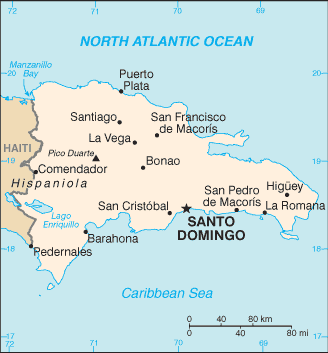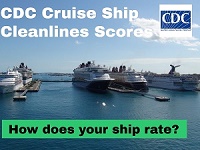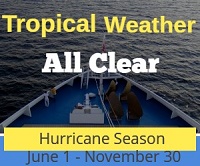Cayo Leventado Cruise Ship Port
Cruise Ship Port of Call information like Port News, Weather, Transportation Options, Things to Do and See, Area Events, Medical Care, Crime and Safety Review
Venice
Get to know our slice of Paradise - located on the SW Coast of Fl.
Attractions
Beaches
Canoe/Kayak
Boat Launches
Boat Charters
Fishing Charter
Fishing Piers
Historical Sites
Golf
Parks
Hotels
Relocate
Venice Map
More Port Calls
Bahamas
Castaway Cay
Freeport
Coco Cay
Half Moon Cay
Nassau
Princess Cay
Stirrup Cay
Eastern Caribbean
Anguilla
Antigua
Casa de Campo
Catalina Island
Grand Turk
Labadee
La Romana
Samana
San Juan
St. John
St. Croix
St. Thomas
St. Maarten/Dutch
St. Martin/French
Tortola
Samana Area Weather
Hurricanes
The Dominican Republic is situated in an area prone to hurricanes. From June to November, the country may experience strong winds and rains as a result of hurricanes in the Atlantic.
In the event of a tropical storm or hurricane, go to our Tropical Storm Update page
Getting Around
About Taxi Cabs/Public Transportation
With respect to taxis, visitors to the Dominican Republic are strongly advised to take only hotel taxis or taxis operated by services whose cabs are arranged in advance by phone and can subsequently be identified and tracked. There are continuing reports of thefts that target Americans as they leave the airport in a taxi that lacks air-conditioning. The driver rolls down the windows and when the taxi stops at a traffic light, a motorcyclist reaches in and steals a purse or anything they can grab.
Public transportation vehicles such as the route taxis (“carros publicos”) and urban buses (“guaguas”) are unsafe.
Driving
Visitors to the Dominican Republic might want to consider hiring a professional driver during their stay in lieu of driving themselves. In case of accidents, only the driver will be taken into custody.
Penalties for those driving under the influence and those involved in accidents resulting in injury or death can be severe. Dominican law requires that a driver be taken into custody for driving under the influence or being involved in an accident that causes serious injury or death, even if the driver is insured and appears not to have been at fault. The minimum detention period is 48 hours; however, detentions frequently last until a judicial decision is reached (often weeks or months), or until a waiver is signed by the injured party (usually as the result of a cash settlement).
Traffic laws are similar to those in the United States, but undisciplined driving is common, due to a lack of adequate traffic controls. Many drivers will not use turn indicators. Rather, it is common for a vehicle operator to stick his hand out the window to signal a turn.
Drivers can also be aggressive and erratic, often failing to yield the right-of-way even when road signs or signals indicate that they should.
Traditionally, vehicles involved in accidents in the Dominican Republic are not moved (even to clear traffic), until authorized by a police officer. Drivers who violate this norm may be held legally liable for the accident.
Pedestrians tend to step out into traffic without regard to corners, crosswalks, or traffic signals. Pedestrians do not have the right-of-way, and walking along or crossing busy streets – even at intersections with traffic lights or traffic police present – can be very dangerous.
Seat belts are required by law, and those caught not wearing them will be fined. There are no child car seat laws. The law also requires the use of hands-free cellular devices while driving. Police stop drivers using cell phones without the benefit of these devices.
Area Events
ports > destinations > Cayo Leventado
Cayo Leventado, DR
|
Cayo Levantado is a small area of land on the Dominican Republic’s north-east coast, in Bahia de Samaná on the Samaná Peninsula.

One of the major reasons the town of Samaná is on the tourism map is because it is one of the best places in the world to observe dozens of humpback whales in their natural environment.
This awe-inspiring activity will take you near Cayo Levantado amidst turquoise waters of the Bahía de Samaná, where the giant, white-finned humpbacks practice their mating rituals.
Every year, thousands of these huge mammals come from the faraway waters of Greenland and Iceland to the Bahía de Samaná.
Good to Know
Port of Entry
Cayo Levantado is a small island in the Bay of Samana measuring about one square kilometer and made of a protruding coral reef which protects Samana bay from the Atlantic waves.
Cruise Line: MSC Cruises
Due to the island’s protected positioning in the bay, the waters are calm, shallow with a plush sandy bottom.
Visitors to the Dominican Republic, including to local resort areas, should carefully assess the potential risk of recreational activities. Some of the swimming areas at popular beaches around the Dominican Republic are subject to dangerous undertows. Many beaches lack life guards and/or warnings of unsafe conditions. Resort managers usually offer current information on local swimming & surf conditions. Americans are cautioned not to swim alone, particularly at isolated beaches.
The Dominican Republic is situated in an area of the Caribbean prone to hurricanes.
Time Zone
AST (UTC/GMT -4 )
Map Coordinates
19.12ºN, 69.27º W
Average Temperatures
Water: 82 ºSummer -78 º Winter
Air: 85 º Summer - 79º Winter
Personal Safety
Street crime and petty theft involving U.S. tourists does occur, and precautions should be taken to avoid becoming a target. While pick pocketing and mugging are the most common crimes against tourists, reports of violence against both foreigners and locals are growing.
The overall level of crime tends to rise during the Christmas season, and visitors to the Dominican Republic should take extra precautions when visiting the country between November and January.
Tourist Police
The Dominican Republic does have police that are specially trained to assist tourists who require assistance. This public institution is called Politur and represents a cooperative effort between the National Police, Secretary of the Armed Forces, and the Secretary of Tourism.
Medical Services
Medical care is limited, especially outside Santo Domingo, and the quality of care varies widely among facilities.
Outside the capital, emergency services range from extremely limited to nonexistent. Blood supplies at both public and private hospitals are often limited, and not all facilities have blood on hand even for emergencies.
Many medical facilities throughout the country do not have staff members who speak or understand English.
Attractions
The city of Samaná is located in a small plain close to the coast but, now, most of the city is in the hills that enclose the plain. It is the largest municipality of the province.
Whale Watching
In the season (mid January to mid March) the town of Samaná is the focus for guided and regulated whale watching trips, although many small operators offer trips from various embarkation points between Samaná and Las Galeras. If you don't schedule an excursion through your cruise company, make sure your captain and guide have permits to enter the whale watch area, have been certified by the Whale Sanctuary Commission and CEBSE, and comply with the regulations.
Los Haitises National Park
With its keys and caves, Los Haitises is an important mangrove and tropical rain forest reserve and home to the endangered manatee, many birds, reptiles and bats. Guided boat trips to Los Haitises are run from the same places mentioned above as well as from Sanchez. Visitors may only enter the national park with a certified guide.
Las Terrenas
Las Terrenas is a new hotspot for foreigners but also people from the Capital of Santo Domingo since the highway has been completed. Shopping and restaurants.
El Limon Waterfall
At the town of El Limon. The waterfall is about 300 meters above sea level and has a 40 meter drop that ends in a very deep pool of crystal clear waters.
There are four access routes to the falls located about midway along the road joining Las Terrenas on the north coast with Samaná on the south coast. Four small communities-Rancho Espanol, Arroyo Surdido, El Café and El Limón-have organized entry points, or 'paradas', offering guided horseback treks to the falls. Food and beverages, local produce such as coffee, cocoa, grapefruit, coconuts and handicrafts can also be purchased at these paradas.







